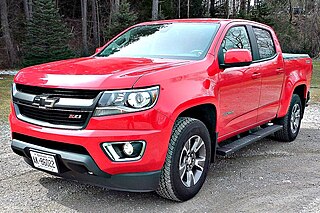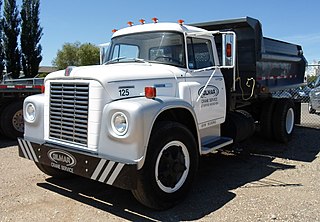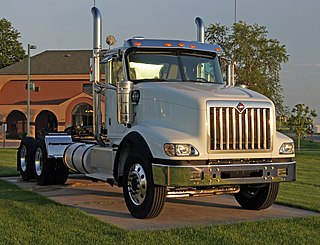
The Chevrolet Colorado, and its counterpart, the GMC Canyon, are series of compact and later mid-sized pickup trucks marketed by American automaker General Motors. They were introduced in 2004 to replace the Chevrolet S-10 and GMC S-15/Sonoma compact pickups. It is named for the U.S. state of Colorado.

The Ram pickup is a full-size pickup truck manufactured by Stellantis North America and marketed from 2010 onwards under the Ram Trucks brand. The current fifth-generation Ram debuted at the 2018 North American International Auto Show in Detroit, Michigan, in January of that year.

The International Harvester Company was an American manufacturer of agricultural and construction equipment, automobiles, commercial trucks, lawn and garden products, household equipment, and more. It was formed from the 1902 merger of McCormick Harvesting Machine Company and Deering Harvester Company and three smaller manufactures: Milwaukee; Plano; and Warder, Bushnell, and Glessner. In the 1980s all divisions were sold off except for International Trucks, which changed its parent company name to Navistar International. Its brands included McCormick, Deering, and later McCormick-Deering, as well as International. Along with the Farmall and Cub Cadet tractors, International was also known for the Scout and Travelall vehicle nameplates.

Navistar International Corporation is an American holding company created in 1986 as the successor to International Harvester. Navistar operates as the owner of International brand of trucks and diesel engines. The company also produces buses under the IC Bus brand. On July 1, 2021, Navistar became a wholly owned subsidiary of Traton, and therefore part of the Volkswagen Group.

The Ford Super Duty is a series of trucks manufactured by the Ford Motor Company. Introduced in 1998 for the 1999 model year, the F-Series Super Duty trucks marked the addition of a heavy-duty pickup to the Ford F-Series range with the new versions of the F-250, F-350, and F-450 trucks, while the previous 1987–1997 F-Super Duty chassis cabs were replaced by the F-450 chassis cab and F-550 Super Duty.

The medium-duty version of the Ford F-Series is a range of commercial trucks manufactured by Ford since 1948. Derived from the smaller F-Series pickup trucks, the medium-duty range is currently in its eighth generation. Initially slotted between the F-Series pickup trucks and the "Big Job" conventionals, later generations were slotted below the L-Series "Louisville" trucks; the last two generations are the largest vehicles produced by Ford since its exit from the heavy-truck segment.
The International DuraStar, is a product line of medium-duty trucks produced by Navistar International from 2001 to 2018. Introduced as the successor to the International 4000 series of 1989–2001, the 4000 series was renamed the DuraStar in 2008. Developed as a Class 6-7 product range, the 4000/DuraStar was slotted below the 8000/TranStar regional-haul semitractor, with the Class 5 International TerraStar (2010–2015) serving as the smallest International conventional-cab product range.

The International TranStar, is a range of Class 8 trucks produced by Navistar International for North America. Produced nearly exclusively as a semitractor, the product range is focused towards local delivery and regional shipping.

The International Loadstar is a series of trucks that were produced by International Harvester from 1962 to 1978. The first product line of the company developed specifically as a medium-duty truck, the Loadstar was slotted between C-Line pickup trucks and the heavy-duty R-series. Following the discontinuation of the R-series, the Loadstar was slotted below the Fleetstar and Transtar conventionals.

The International S series is a range of trucks that was manufactured by International Harvester from 1977 to 2001. Introduced to consolidate the medium-duty IHC Loadstar and heavy-duty IHC Fleetstar into a single product range, the S series was slotted below the Transtar and Paystar Class 8 conventionals.

The International ProStar is a line of Class 8 trucks that was manufactured by Navistar International from 2006 to 2017. Marking the introduction of the "-Star" branding nomenclature to International, the conventional-cab ProStar replaced the 9400i. Competing against the Freightliner Cascadia and the Kenworth T2000/Peterbilt 387, the ProStar was an aerodynamically-enhanced conventional.

The International Paystar is a series of trucks that was manufactured by International Harvester and its successor, Navistar International. Produced from 1972 to 2016 across three generations, the Paystar replaced the long-running 210/230 and M-series.

The COE version of the International 9000 is a series of cabover trucks that were produced by International Harvester and its corporate successor Navistar. Introduced in 1981 as the replacement for the Transtar II COE, two generations of the model line were produced in North America until 1998. Subsequent production continued into the 21st century in worldwide markets, where more restrictive length laws still favor the use of the configuration.

The International 3300 is a Type-C cowled bus chassis (conventional-style) manufactured by Navistar International since 2004 for the United States, Canada, and Mexico. While most examples are produced as yellow school buses, variants of the 3300 are also produced for commercial applications; International also produces as cutaway-cab variant of the model line.

The International 9000 Series is a range of trucks that was manufactured by Navistar International. Introduced as the Transtar 4000 in 1971, the model line was produced across three generations until 2017; following the incorporation of Navistar, the Transtar was rebranded as the 9000 series. Slotted below the Paystar range, the 9000 series was a conventional-cab truck configured primarily for highway applications.

The International WorkStar is a line of severe duty trucks made by International Truck. The WorkStar is the successor to the 7400 and 7600 series trucks produced by International. Starting in 2008 the "thousand series" name was dropped in favor of the WorkStar. This change was reflected in the physical construction of the truck in the form of a new hood and grill along with increased MaxxForce Engine options.
NC2 Global is a heavy truck and engine manufacturer that was a 50/50 joint venture of Navistar International and Caterpillar Inc. based in Chicago, Illinois. It was formed in September 2009 to "develop, manufacture and distribute commercial trucks globally, outside North America and India". However, the JV was dissolved in 2011 and NC2 is now a wholly owned subsidiary of Navistar International. Vehicles distributed in Australia are branded CAT as part of the agreement.

The Freightliner Argosy is a model line of cabover trucks that was produced by the American truck manufacturer Freightliner from the 1999 to 2020 model years. Developed as the replacement for the FLB cabover, the Argosy was a Class 8 truck, configured primarily for highway use. Competing against the International 9800, Kenworth K100E, and Peterbilt 362, the Argosy was the final Class 8 cabover marketed in North America, following the decline in use of the design in the United States and Canada.

The Ford LCF is a medium-duty cab-over truck that was marketed by Ford Motor Company from 2006 to 2009. The first cab-over (COE) vehicle sold by Ford since the company sold the rights to the Ford Cargo design to Freightliner in 1996, the LCF was developed as a Class 4/5 truck, competing in a market segment dominated by the Isuzu NPR. Sold in various wheelbases, the model line was developed for various configurations, including dump trucks, fire trucks, tow trucks, box trucks, crane/bucket trucks, flat beds and stake bodies.




















